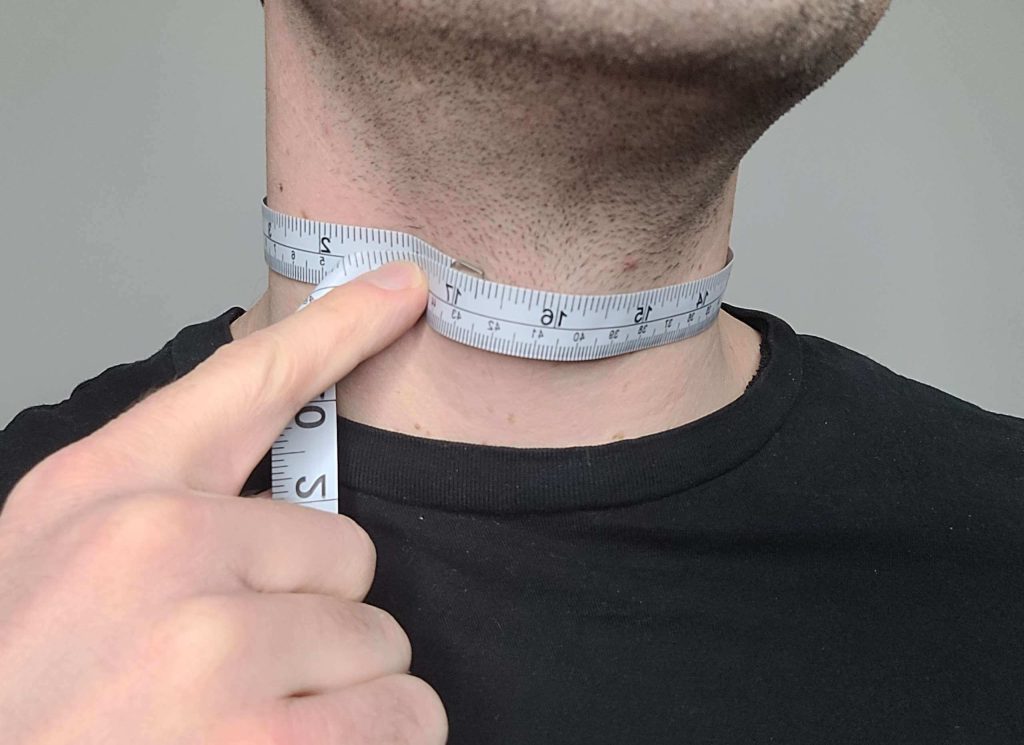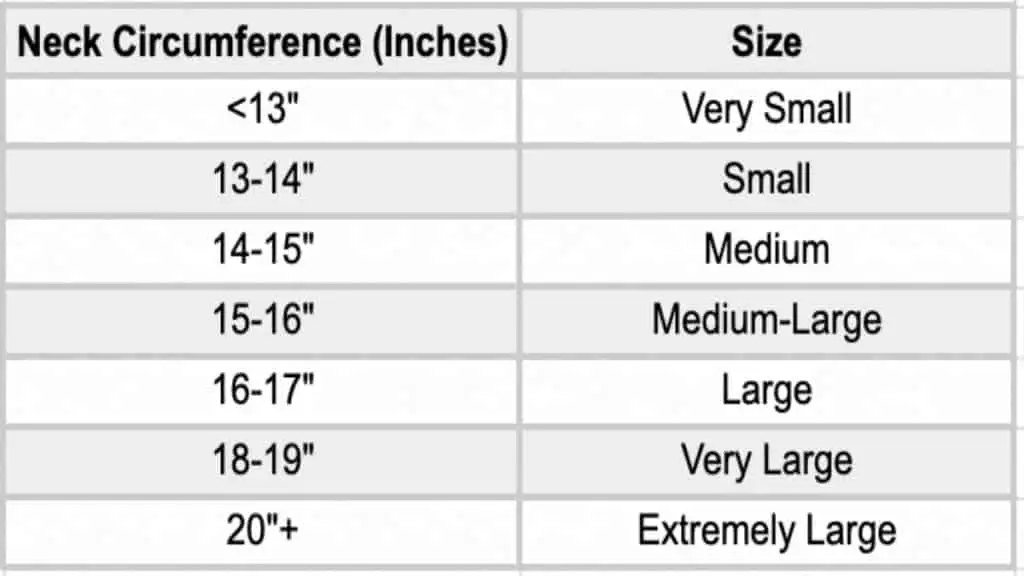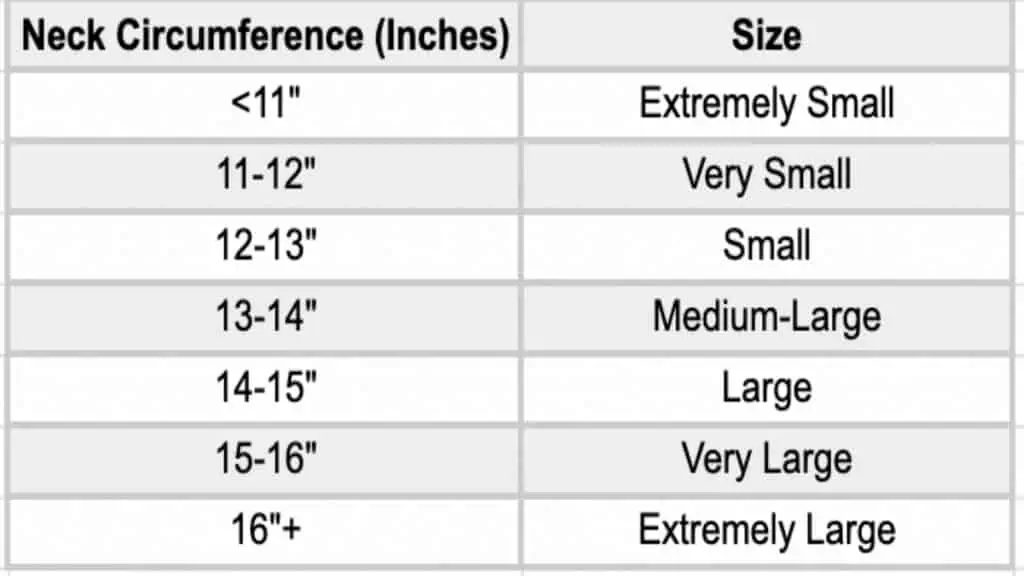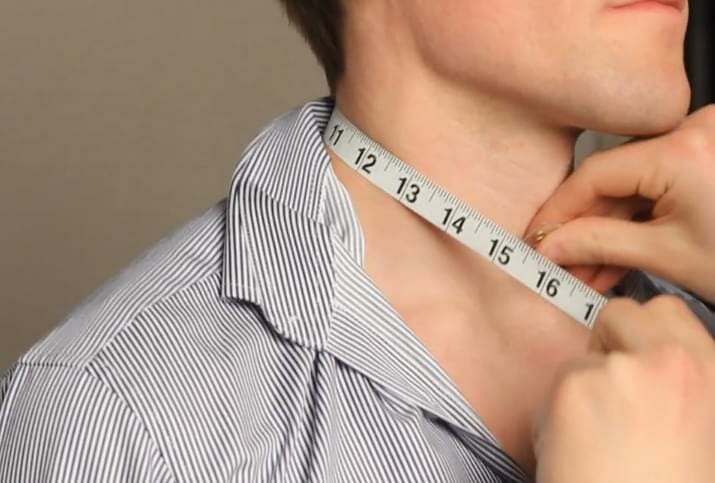
Welcome to the right place if you’re curious about the average neck size for men and women, as well as the impact of these measurements on your health. We have compiled information from multiple scientific studies and peer-reviewed journals, focusing on anthropometric data, to determine the typical neck circumference for both males and females.
To help you assess your current health status accurately, we have provided a men’s neck chart and a women’s neck size chart. These charts will guide you on where and how to measure your neck circumference.
By knowing your neck size, you can gain insights into your health. Neck circumference has been linked to various health conditions, such as sleep apnea, obesity, and cardiovascular disease. Regularly monitoring your neck size can be a helpful indicator of your overall well-being.

Remember, accurate measurements are key to understanding your health status, so be sure to follow the guidelines provided and use the appropriate tools.
Related Measurement Guides:
- Average wrist size
- Average male bicep circumference
- Average forearm circumference
- Average hip measurement
- Average leg circumference
- Average waist measurement
- Average calf circumference
- Average men’s chest size
- Average shoulder width
Contents
- What is the average male neck size?
- What is the average neck size for a woman?
- What is the average neck circumference for children and teenagers?
- Men’s neck size chart
- Female neck size chart
- How to measure your neck size correctly?
- What is considered a large neck circumference?
- Neck Circumference FAQs
- What is the average neck size by height?
- What is the average neck circumference by age?
- Where should you measure your neck for body fat testing?
- How to measure your neck size without a measuring tape?
- How to measure your neck height and length?
- Should you aim to have an average neck circumference?
- Conclusion
- References
- Related
What is the average male neck size?
The average neck size for men varies, but it typically falls within a certain range. Based on studies and data, the average male neck circumference is around 15 to 16 inches. However, it’s important to note that individual variations exist, and factors such as age, body composition, and overall health can influence neck size.
When measuring your neck circumference, it’s crucial to follow the proper guidelines to obtain accurate results. Use a flexible tape measure and locate the midpoint of your neck, which is usually just below Adam’s apple. Wrap the tape measure around your neck, ensuring it’s snug but not too tight, and read the measurement where the tape meets.
Knowing your neck size can provide insights into your health. In some cases, a larger neck circumference may indicate an increased risk of certain health conditions such as sleep apnea, obesity, and cardiovascular disease. Regular monitoring of neck size can serve as a valuable indicator of your overall well-being.

Keep in mind that these measurements are based on averages, and it’s essential to consult with a healthcare professional if you have any concerns about your neck size or health. They can provide personalized guidance and help interpret the measurements in the context of your individual circumstances.
Common Neck Sizes:
- 11 inch neck
- 12 inch neck
- 13 inch neck
- 14 inch neck
- 15 inch neck
- 16 inch neck
- 17 inch neck
- 18 inch neck
- 19 inch neck
- 20 inch neck
- 21 inch neck
- 22 inch neck
What is the average neck size for a woman?
The average neck size for women can vary, but generally, it falls within a certain range. On average, women’s necks measure around 12 to 13 inches in circumference. However, it’s important to remember that everyone’s body is unique, and there can be variations among individuals. Neck size is influenced by various factors such as genetics, overall body size, and muscular development.
It’s crucial to consider neck size for a proper fit when it comes to clothing and accessories like necklaces or collars. It’s recommended to measure your own neck if you’re unsure about your size. You can use a measuring tape and wrap it around the base of your neck, just below Adam’s apple, to get an accurate measurement.
Maintaining a healthy neck is essential for overall well-being. Simple exercises like neck stretch and rotations can help alleviate stiffness and tension. Good posture and avoiding excessive strain on the neck are also beneficial.

Remember, these are general guidelines, and individual measurements may vary. If you have specific concerns about your neck size or health, it’s always best to consult with a healthcare professional who can provide personalized advice and guidance.
What is the average neck circumference for children and teenagers?
The average neck circumference for children and teenagers can vary based on their age and growth. On average, children between the ages of 5 and 12 have a neck circumference of about 10 to 12 inches. As they enter their teenage years, the average neck circumference increases to around 12 to 14 inches. It’s important to note that these are general ranges, and individual measurements can vary.
Measuring a child’s neck circumference is similar to measuring an adult’s. You can use a measuring tape and wrap it around the base of the child’s neck, just below the Adam’s apple. It’s helpful to measure while the child is standing upright and looking straight ahead.

Maintaining good posture and practicing neck exercises can promote a healthy neck for children and teenagers. Encouraging proper ergonomics while using devices or studying can also help prevent neck strain and discomfort.
If you have concerns about your child’s neck size or health, it’s advisable to consult with a healthcare professional who can provide personalized guidance and advice.
Men’s neck size chart
Our male neck size chart is formulated using a comprehensive analysis of anthropometric data, which includes both in-house research and findings from scientific studies.
It is important to note that the provided figures are not meant to indicate precise clothing sizes, although they might align with specific clothing brands in certain cases.
Instead, the designations of “small,” “medium,” “large,” and so on are determined by comparing the actual size of your neck to the average neck measurements.

Therefore, we have included separate neck measurement charts for males and females, as, on average, males tend to have thicker necks compared to females.
Female neck size chart
Utilize the provided female neck circumference chart as a valuable tool to assess the relative size of your neck compared to the average woman. By measuring your neck circumference and referencing the chart, you can determine whether your neck falls into larger categories. It is worth noting that if your neck measurement falls into one of these larger categories, it is probable that your waist size and body mass index (BMI) are also higher than average.

These three measurements – neck circumference, waist size, and BMI – tend to exhibit a correlation. Therefore, by recognizing the relationship between these factors, you can gain insights into your overall body composition and potential areas of focus for maintaining or improving your health and fitness.
How to measure your neck size correctly?

To measure your neck size correctly, follow these simple steps:
- Get a flexible measuring tape.
- Stand straight and keep your head in a natural position.
- Place one end of the tape at the base of your neck, where it meets your shoulders.
- Wrap the tape around your neck, just below your Adam’s apple.
- Make sure the tape is snug but not too tight.
- Keep the tape parallel to the ground and ensure it’s not twisted.
- Read the measurement where the end of the tape meets the rest of the tape.
- Note down the measurement in inches or centimeters.
Remember, for accurate results; it’s important to measure your neck when it’s at a normal size—avoid measuring right after exercise or physical activity. Repeat the process a couple of times to ensure consistency in the measurements.
Using these easy steps, you can measure your neck size accurately and find the right fit for collars, necklaces, or clothing.
What is considered a large neck circumference?
A large neck circumference is typically determined by measuring the distance around the neck. For adults, a neck circumference greater than 16.5 inches (42 cm) for men and 15 inches (38 cm) for women is generally considered large. However, it’s important to note that individual body types and sizes can vary, so these measurements may not apply to everyone.

Having a larger neck circumference could be due to factors such as muscle mass, body fat distribution, or underlying medical conditions. If you are concerned about your neck circumference or its implications on your health, it is best to consult with a healthcare professional who can provide personalized guidance and recommendations. Remember, it’s important to focus on overall health rather than just a single measurement.
Neck Circumference FAQs
In this comprehensive FAQs, you’ll discover all the essential information about neck measurements. Gain a thorough understanding of what constitutes a large neck circumference and its significance for your overall health.
What is the average neck size by height?
The average neck size varies based on a person’s height. Tall individuals generally have larger necks compared to shorter ones. However, it’s important to note that individual variations exist, and these are general trends.
For individuals of shorter height, typically around 5 feet (152 cm) or less, the average neck size ranges from about 14 to 15 inches (36 to 38 cm).
For those with a moderate height of around 5 feet 4 inches to 5 feet 8 inches (163 to 173 cm), the average neck size tends to be around 15 to 16 inches (38 to 41 cm).
Taller individuals, usually over 6 feet (183 cm), tend to have neck sizes ranging from 16 to 17.5 inches (41 to 44 cm).
Remember that these figures are averages and can vary depending on factors like body composition and genetics. Additionally, it’s important to measure neck size accurately using a flexible measuring tape placed around the neck just below Adam’s apple without pulling it too tight or allowing it to sag.
What is the average neck circumference by age?
The average neck size can vary based on a person’s height. However, it’s important to note that neck size alone is not typically used as a standard measurement for height. Body proportions can differ between individuals.
For instance, on average, someone who is shorter in height might have a neck size between 14 and 15 inches, while someone who is taller may have a neck size between 15 and 16 inches. It’s worth mentioning that these are just general estimates, and individual differences can occur. Additionally, it’s important to focus on overall health rather than comparing specific body measurements. Remember, our bodies come in different shapes and sizes, and what matters most is maintaining a healthy lifestyle.
Where should you measure your neck for body fat testing?
To measure your neck for body fat testing, follow these simple steps. First, stand up straight and make sure your neck is relaxed. Then, take a flexible measuring tape and place it around your neck, just below your Adam’s apple. Keep the tape parallel to the floor and snug against your skin without pressing too tightly. Breathe normally and avoid sucking in your stomach.
Make sure that the tape is not twisted, and read the measurement in inches or centimeters. To increase accuracy, take three measurements and calculate the average. Remember, body fat testing is just one tool to assess your overall health, and it’s important to consult with a healthcare professional for a comprehensive evaluation.
How to measure your neck size without a measuring tape?
If you don’t have a measuring tape, don’t worry! You can still measure your neck size using a simple method. Here’s how:
- Find a piece of string or a long, thin strip of paper.
- Wrap the string or paper around your neck, just below your Adam’s apple.
- Make sure the string or paper is snug but not too tight.
- Hold the end of the string or paper where it meets the rest of it.
- Take the string or paper and lay it flat on a flat surface, like a table.
- Use a ruler or any other straight measuring tool to measure the length of the string or paper in inches or centimeters.
- The measured length is your neck size.
Remember to measure accurately and double-check your measurement for the best results.
How to measure your neck height and length?
To measure your neck height and length, follow these simple steps:
- Stand up straight with your head in a neutral position.
- Place a measuring tape around the base of your neck, just above your shoulders.
- Keep the measuring tape parallel to the ground and snug against your skin without pressing too tightly.
- Read the measurement in inches or centimeters where the tape overlaps.
- This measurement represents your neck circumference or “neck height.”
- To measure your neck length, start by finding the prominent bone at the base of your neck.
- Measure from this bone vertically to the point where your neck meets your collarbone.
- Again, use a measuring tape and read the measurement in inches or centimeters.
- This measurement represents your neck length.
- Repeat the process a few times to ensure accuracy.
- Note down the measurements for future reference.
By following these steps, you can easily measure your neck height and length.
Should you aim to have an average neck circumference?
No, there is no need to aim for an average neck circumference. Neck circumference can vary greatly among individuals based on factors such as genetics, body composition, and overall health. It is more important to focus on maintaining a healthy lifestyle through regular exercise and a balanced diet. Engaging in exercises that target the neck and surrounding muscles can help improve posture and strengthen the neck.
However, it’s essential to consult with a healthcare professional or a qualified fitness trainer before starting any exercise regimen. Remember, everyone’s body is unique, and it’s more important to prioritize overall well-being and healthy habits rather than aiming for a specific neck circumference.
Conclusion
In conclusion, understanding the average neck size for men and women, as well as its implications for health, can provide valuable insights into overall well-being. Neck circumference has been linked to various health conditions, and monitoring it regularly can serve as an indicator of potential risks. However, it’s important to note that individual variations exist, influenced by factors such as age, genetics, and body composition.
Accurate measurements using a flexible tape measure are crucial for assessing neck size correctly. It’s recommended to consult with a healthcare professional for personalized guidance and interpretation of measurements.
Additionally, maintaining good posture, practicing neck exercises, and avoiding excessive strain on the neck can contribute to a healthy neck. Keep in mind prioritizing overall health and well-being is more important than aiming for a specific neck circumference.
References
- Wirth B, Amato M, Hauser W, et al. Neck size in adults: normal values and clinical implications. Sleep Breath. 2017;21(2):463-469. doi:10.1007/s11325-016-1457-2
- Iida K, Ito Y, Kawai T, et al. Neck circumference as a predictor of cardiovascular events in a general population: A meta-analysis of prospective studies. J Clin Hypertens (Greenwich). 2019;21(8):1129-1136. doi:10.1111/jch.13598
- Stein PK, Pu Y. Neck circumference, cardiometabolic risk, and cardiovascular diseases: Recent evidence and future directions. J Lipid Atheroscler. 2020;9(2):194-204. doi:10.12997/jla.2020.9.2.194
- Thomas GN, Ho SY, Janus ED, et al. The U-shaped relationship between body mass index and mortality in a large prospective cohort study. Eur J Epidemiol. 2004;19(5):357-362. doi:10.1023/B:EJEP.0000020154.40973.a4